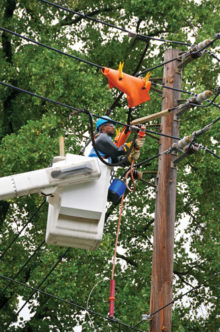Elevating work platforms

Commonly used in the construction industry, elevating work platforms are a valuable tool for workers who need to work at height. But as with any machinery, EWPs must be operated correctly to keep workers safe.
The Canadian Center for Occupational Health and Safety recommends following the manufacturer’s instructions when operating these devices and allowing only employees with the appropriate training to operate EWPs. Operator controls should be at the platform level, and emergency override controls should be at ground level.
Before beginning any job involving an EWP, CCOHS says, check the area for hazards such as ditches, drop-offs and holes; debris or other obstructions; untamped earth fills; and overhead obstructions such as power lines.
Inspection checklist
It’s important to thoroughly inspect EWPs before using them, as well as keep a written log of all inspections and repairs. CCOHS recommends checking for loose connections, cracked welds, damaged or frayed wire ropes, improper adjustments, and broken safety devices such as horns, emergency controls and gates. Check the frame, brakes and tires for signs of damage or wear and tear. Ensure load capacity signs are in place.
Moving and raising the platform
Before moving or raising an EWP, make sure it’s placed on a level, firm surface, CCOHS states. Have outriggers or stabilizers properly positioned, and ensure all platform guardrails are properly installed. Additional tips:
- Keep an eye on ropes, cords and hoses at the jobsite to ensure they don’t get tangled up in the work platform.
- Load the platform evenly, and be careful not to overload it. Follow the manufacturer’s instructions regarding loading.
- Never put the operator in the position of being trapped between the platform and the structure being worked on.
- Keep the area clear of other workers when the platform is being moved, raised or lowered.
Post a comment to this article
Safety+Health welcomes comments that promote respectful dialogue. Please stay on topic. Comments that contain personal attacks, profanity or abusive language – or those aggressively promoting products or services – will be removed. We reserve the right to determine which comments violate our comment policy. (Anonymous comments are welcome; merely skip the “name” field in the comment box. An email address is required but will not be included with your comment.)

